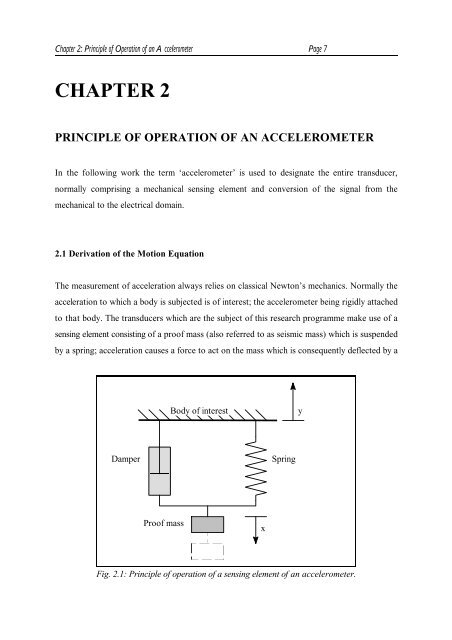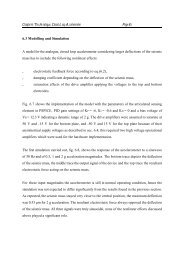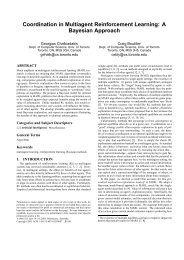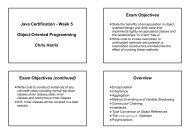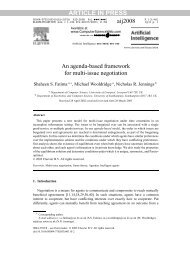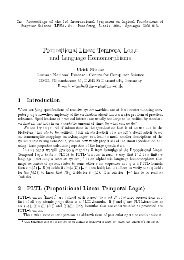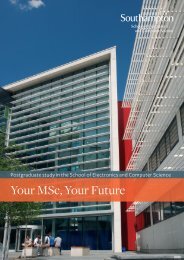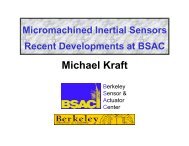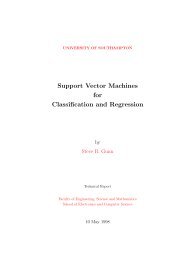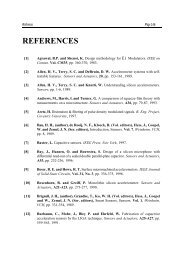Chapter 2: Principle of Operation of an Accelerometer
Chapter 2: Principle of Operation of an Accelerometer
Chapter 2: Principle of Operation of an Accelerometer
Create successful ePaper yourself
Turn your PDF publications into a flip-book with our unique Google optimized e-Paper software.
<strong>Chapter</strong> 2: <strong>Principle</strong> <strong>of</strong> <strong>Operation</strong> <strong>of</strong> <strong>an</strong> <strong>Accelerometer</strong> Page 7<br />
CHAPTER 2<br />
PRINCIPLE OF OPERATION OF AN ACCELEROMETER<br />
In the following work the term ‘accelerometer’ is used to designate the entire tr<strong>an</strong>sducer,<br />
normally comprising a mech<strong>an</strong>ical sensing element <strong>an</strong>d conversion <strong>of</strong> the signal from the<br />
mech<strong>an</strong>ical to the electrical domain.<br />
2.1 Derivation <strong>of</strong> the Motion Equation<br />
The measurement <strong>of</strong> acceleration always relies on classical Newton’s mech<strong>an</strong>ics. Normally the<br />
acceleration to which a body is subjected is <strong>of</strong> interest; the accelerometer being rigidly attached<br />
to that body. The tr<strong>an</strong>sducers which are the subject <strong>of</strong> this research programme make use <strong>of</strong> a<br />
sensing element consisting <strong>of</strong> a pro<strong>of</strong> mass (also referred to as seismic mass) which is suspended<br />
by a spring; acceleration causes a force to act on the mass which is consequently deflected by a<br />
Body <strong>of</strong> interest<br />
y<br />
Damper<br />
Spring<br />
Pro<strong>of</strong> mass<br />
x<br />
Fig. 2.1: <strong>Principle</strong> <strong>of</strong> operation <strong>of</strong> a sensing element <strong>of</strong> <strong>an</strong> accelerometer.
<strong>Chapter</strong> 2: <strong>Principle</strong> <strong>of</strong> <strong>Operation</strong> <strong>of</strong> <strong>an</strong> <strong>Accelerometer</strong> Page 8<br />
dist<strong>an</strong>ce ‘x’as shown in fig. 2.1. Some form <strong>of</strong> damping is required, otherwise the system would<br />
oscillate at its natural frequency ‘Tn’ for <strong>an</strong>y input signal.<br />
To derive the motion equation <strong>of</strong> the system, D’Alembert’s principle is applied, where all real<br />
forces acting on the pro<strong>of</strong> mass are equal to the inertia force on the pro<strong>of</strong> mass, Timoshenko <strong>an</strong>d<br />
Young [100]. From the stationary observer’s point <strong>of</strong> view, the sum <strong>of</strong> all forces in the y direction<br />
is:<br />
m d 2 y<br />
dt 2<br />
0 ’ &m d 2 (y&x)<br />
dt 2<br />
’ m d 2 x<br />
dt 2<br />
% b dx<br />
dt<br />
% b dx<br />
dt<br />
% kx<br />
% kx ...(2.1)<br />
where:<br />
m: mass <strong>of</strong> the pro<strong>of</strong> mass,<br />
y: movement <strong>of</strong> the body <strong>of</strong> interest,<br />
x: movement <strong>of</strong> the pro<strong>of</strong> mass,<br />
b: damping factor (assumed to be const<strong>an</strong>t, for this consideration),<br />
k: spring const<strong>an</strong>t.<br />
The second derivative <strong>of</strong> ‘y’ with respect to time is the acceleration ‘a’ <strong>of</strong> the body <strong>of</strong> interest.<br />
2.2 Steady State Perform<strong>an</strong>ce<br />
In the steady state condition, that is with const<strong>an</strong>t acceleration ‘a’ <strong>an</strong>d const<strong>an</strong>t deflection ‘x’,<br />
eq. (2.1) yields:<br />
ma ’ kx<br />
a ’ kx m<br />
...(2.2)
<strong>Chapter</strong> 2: <strong>Principle</strong> <strong>of</strong> <strong>Operation</strong> <strong>of</strong> <strong>an</strong> <strong>Accelerometer</strong> Page 9<br />
Here the sensitivity ‘S’ <strong>of</strong> <strong>an</strong> accelerometer is defined by:<br />
S ’ x a ’ m k<br />
...(2.3)<br />
2.3 Dynamic Perform<strong>an</strong>ce<br />
For the dynamic perform<strong>an</strong>ce it is easier to consider the Laplace tr<strong>an</strong>sform <strong>of</strong> eq. (2.1):<br />
x(s)<br />
a(s) ’ 1<br />
s 2 % b m s% k m<br />
...(2.4)<br />
From this equation, the natural frequency ‘Tn’ is<br />
T n<br />
’<br />
k<br />
m<br />
...(2.5)<br />
An upper boundary <strong>of</strong> the b<strong>an</strong>dwidth <strong>of</strong> <strong>an</strong> open loop accelerometer is its natural frequency. It<br />
c<strong>an</strong> be seen by comparing eq. (2.3) <strong>an</strong>d eq. (2.5) that the b<strong>an</strong>dwidth <strong>of</strong> <strong>an</strong> accelerometer sensing<br />
element has to be traded <strong>of</strong>f with its sensitivity since S % 1/Tn² (This trade-<strong>of</strong>f c<strong>an</strong> be partly<br />
overcome by applying feedback, which is discussed later).<br />
For the dynamic perform<strong>an</strong>ce <strong>of</strong> <strong>an</strong> accelerometer the damping factor ‘b’ is crucial. For maximum<br />
b<strong>an</strong>dwidth the pro<strong>of</strong> mass should be critically damped; it c<strong>an</strong> be shown that for b = 2mTn this is<br />
the case. It should be noted here that in micromachined accelerometers the damping originates<br />
from the movement <strong>of</strong> the pro<strong>of</strong> mass in a viscous medium. However, depending on the<br />
mech<strong>an</strong>ical design, the damping coefficient ‘b’c<strong>an</strong>not be assumed to be const<strong>an</strong>t; this phenomena<br />
will be discussed in sec. 5.3.
<strong>Chapter</strong> 2: <strong>Principle</strong> <strong>of</strong> <strong>Operation</strong> <strong>of</strong> <strong>an</strong> <strong>Accelerometer</strong> Page 10<br />
2.4 Closed Loop <strong>Accelerometer</strong><br />
The accelerometer discussed above, in which the deflection <strong>of</strong> the pro<strong>of</strong> mass provides a measure<br />
for the acceleration, is commonly referred to as <strong>an</strong> open loop accelerometer. High perform<strong>an</strong>ce<br />
tr<strong>an</strong>sducers have traditionally made use <strong>of</strong> some form <strong>of</strong> feedback where <strong>an</strong> external force is used<br />
to compensate the inertia force on the pro<strong>of</strong> mass due to the acceleration, thus keeping the pro<strong>of</strong><br />
mass at zero deflection (x = 0). This c<strong>an</strong> be approximately achieved by a closed loop structure<br />
depicted in fig. 2.2<br />
Accelerating<br />
force<br />
F=ma<br />
-<br />
Error<br />
signal<br />
Sensing element <strong>of</strong><br />
the accelerometer<br />
x6V<br />
Compensation<br />
Output<br />
signal<br />
Feedback force<br />
Ff<br />
Ff 7 V<br />
Fig. 2.2: Closed loop accelerometer.<br />
The external force has to be derived by a residual deflection <strong>of</strong> the pro<strong>of</strong> mass. The position <strong>of</strong><br />
the pro<strong>of</strong> mass is sensed <strong>an</strong>d converted into a voltage, providing the output signal. The same<br />
voltage is used to generate a feedback force on the pro<strong>of</strong> mass opposing the accelerating input<br />
force. Consequently, the pro<strong>of</strong> mass is only being deflected by the difference between these two<br />
forces which c<strong>an</strong> be considered as the error signal. Some sort <strong>of</strong> compensation may be required<br />
to ensure the stability <strong>of</strong> the loop.<br />
In a closed loop accelerometer the sensitivity ‘S’is not inversely proportional to the square <strong>of</strong> the
<strong>Chapter</strong> 2: <strong>Principle</strong> <strong>of</strong> <strong>Operation</strong> <strong>of</strong> <strong>an</strong> <strong>Accelerometer</strong> Page 11<br />
natural frequency ‘Tn’ <strong>of</strong> the sensing element but depends on the loop gain <strong>an</strong>d the form <strong>of</strong><br />
compensation. Another adv<strong>an</strong>tage is that possible nonlinearities <strong>of</strong> spring <strong>an</strong>d the damping are<br />
reduced considerably if the pro<strong>of</strong> mass stays at or close to its rest position. Furthermore the<br />
b<strong>an</strong>dwidth <strong>of</strong> the accelerometer c<strong>an</strong> be increased past the natural frequency <strong>of</strong> the sensing<br />
element.<br />
In conventional, closed loop accelerometers the feedback force is commonly generated by using<br />
electro-magnetic forces, Sundstr<strong>an</strong>d data sheet [97]. However, in micromachined devices the<br />
dimensions are so small that electrostatic forces c<strong>an</strong> be used to provide the feedback. This has the<br />
adv<strong>an</strong>tage <strong>of</strong> lower power consumption <strong>an</strong>d overcomes the problems <strong>of</strong> m<strong>an</strong>ufacturing<br />
micromachined inductors, Ward <strong>an</strong>d King [109]. At the present time no micromachined<br />
accelerometer is described in the literature that uses electro-magnetic feedback or reset. The<br />
drawback <strong>of</strong> electrostatic feedback with the pro<strong>of</strong> at a defined potential is that the forces are<br />
proportional to the square <strong>of</strong> the voltage, hence they are always positive <strong>an</strong>d consequently<br />
negative feedback is difficult to generate. For this reason the feedback relationship is nonlinear.<br />
These problems are discussed in detail in chapter 6.


